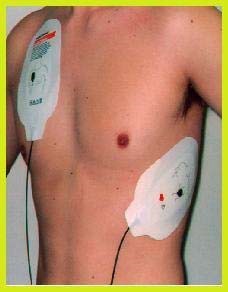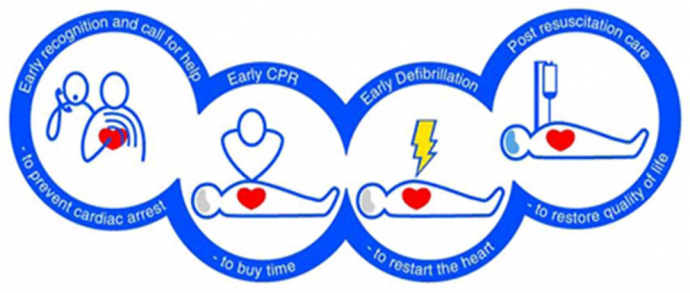The AED will guide you through the entire process until help has arrived.
1. Call 000.
If you see someone collapse, immediately call 000 and get the paramedics en route. If there are other people around, choose someone specific and instruct them to call 000 and explain the situation. This decreases confusion about who should do what and ensures that the call is being placed.
2. Check the patient’s breathing and airway.
If someone has collapsed, you should immediately determine whether they are breathing normally. If the patient is not breathing or not breathing normally, check the airway is clear then begin chest compressions.
3. Locate an AED.
If there is an AED nearby, ask a bystander to bring the AED to you while you continue CPR. Apply the AED electrode pads to the bare chest of the patient and follow the prompts as instructed. Uninterrupted CPR is an important factor in increasing the recovery rate of cardiac arrest patients.
4. Turn on the AED.
5. Attach the electrode pads to patient’s bare
First ensure that the adhesive AED pads are attached to a cable, which is plugged into the AED machine. Then bare the patient’s chest and attach the adhesive AED pads in the appropriate locations. The AED should include a diagram (typically on the adhesive pads themselves) indicating where each pad should be placed on the patient’s chest.

Follow the visual & voice prompts of the AED
Note: CPR should not be interrupted while the adhesive electrode pads are being applied. SAFETY
Do not use on conductive surfaces ‐ water ‐ fluids ‐ metals if you can avoid them.
Do not operate an AED if under the effects of ALCOHOL or DRUGS
Do not touch patient when shock therapy is being delivered.
Do not use in an explosive environment, e.g. oxygen enriched, gaseous or fume environment
AEDs when used within the first 3-5 minutes of a person suffering a Sudden Cardiac Arrest (SCA) can dramatically increase a victims chance of survival from less 5% to as much as 70%. AEDs were designed to be used by virtually anyone with little or no experience.
An AED will automatically analyse the heart rhythm of a pulse less victim and, if the victim is in ventricular fibrillation (VF) or ventricular tachycardia (VT), shock the victim's heart in an attempt to restore its rhythm to normal. AEDs will not shock patients who do not require a shock.
When a heart is in VF, it is still receiving nerve impulses from the brain. These impulses are simply firing so chaotically that the heart cannot produce a "beat"; it cannot expel enough blood to keep the circulatory system flowing through the body. Brain cells begin to die after 4?6 minutes of oxygen deprivation.
The heart will continue its uncoordinated twitching or fluttering until it is no longer receiving electrical impulses from the brain and thus stops all together, or until the heart is shocked back into a normal rhythm, which is where an AED comes in. An AED stops the heart from its spasm by shocking it. This allows the nerve impulses a chance to resume their normal pattern, which, in turn, allows the heart to resume beating at its normal pace.
The ONLY definitive treatment for ventricular fibrillation (VF) is DEFIBRILLATION





